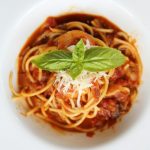
Did somebody say food? An exploration of some of the top European food destinations.
Paris
French cuisine is rated as one of the world’s finest. So Paris is a foregone conclusion on any list of top food cities. French gastronomy is so revered that UNESCO has named it to the list of world intangible cultural heritage. Experience that heritage with classics such as coq au vin or boeuf bourgignon.
Elegant fare by any of the city’s celebrated chefs is a bucket-list experience. Those include Joël Robuchon, Pierre Gagnaire and Alain Ducasse. Ducasse’s eponymous restaurant at Virtuoso property Plaza Athénée is a three-star Michelin delight.
But the culinary joys of Paris aren’t sampled at restaurants alone. Shop for food as the locals do. Visit a market with stalls specializing in everything from cheese to spices. Visit individual specialty stores for baked goods, meat and more. Have an impromptu picnic with the wares you’ve gathered: maybe a baguette, cheese and pate. Or eat a croque monsieur from a street cart.
Up-and-coming trend: Young chefs who do it all at tiny bistros. They’re reinterpreting local ingredients with modern combinations. Expect dishes such as langoustines in artichoke broth or house-made ricotta cheese in olive oil with apricot marmalade.
Barcelona
For years, visitors to Barcelona enjoyed classic Spanish dishes such as paella, ham croquettes, fried calamari, and garlic shrimp.
While they still delight in those standbys, they’re also seeking out the city’s modern contributions to global cuisine.
Barcelona exploded onto the world culinary stage thanks to a native son: Ferran Adrià. His restaurant, elBulli, about 100 miles from Barcelona, gained fame for its very unusual approach to cooking. Adrià’s focus on molecular gastronomy produced creations such as white garlic and almond sorbet, parmesan marshmallows and a dissolving popcorn cloud.
ElBulli closed in 2011, but its influence remains strong in Barcelona. Adrià opened a tapas bar in the city, Tickets, and a fine-dining successor to elBulli, 41 Degrees. ElBulli alumni have opened their own restaurants to critical acclaim. The impact: Barcelona is now home to two dozen Michelin starred restaurants.
Up-and-coming trend: modern cuisine that’s still breaking new ground. Maybe it’s nose-to-tail eating with new twists. Or MediterrAsian food, where Eastern techniques meet Western products including Barcelona’s fresh fish and seafood. Or unconventional combinations, like oysters in gin and tonic. Or novel approaches to local ingredients, such as caviar with smoked sturgeon and poached quail’s egg.
London
If your image of London’s finest cuisine revolves around shepherd’s pie or chicken tikka masala, it’s time to explore all its foodie wonders.
 One of the city’s hottest trends is the arrival of international cuisines you wouldn’t typically associate with England. Latin American and Korean are two examples of the new wave of culinary traditions Londoners are welcoming with open arms. Virtually every cuisine on earth can be found somewhere in the city. And international traditions are fusing with British ingredients, as evidenced by venison kofte and chicken and chorizo pâté.
One of the city’s hottest trends is the arrival of international cuisines you wouldn’t typically associate with England. Latin American and Korean are two examples of the new wave of culinary traditions Londoners are welcoming with open arms. Virtually every cuisine on earth can be found somewhere in the city. And international traditions are fusing with British ingredients, as evidenced by venison kofte and chicken and chorizo pâté.
The other trend: modern revamps of traditional favorites. One example: the humble pub’s transformation into a gastropub. Out are ordinary fish and chips; in is scallop with pink grapefruit gel. Out is traditional roast meat; in is pig’s cheek with watermelon pickle, basil and sesame.
Don’t-miss dining: Dinner by Heston Blumenthal, in Virtuoso property Mandarin Oriental Hyde Park, is one of the world’s finest restaurants. Its strangely named Meat Fruit is the dish to savor. You’re served what appears to be a shiny piece of fruit. Then you discover it’s actually an outer layer of mandarin jelly hiding chicken liver parfait inside.
Copenhagen
A Danish open-faced smorrebrod sandwich is a must when venturing to Copenhagen. Interesting combinations tempt visitors: maybe shrimp with dill, lemon and crème fraiche? Or roast beef with horseradish and crispy fried onions?
 Those looking for smorrebrod variety can find it at a Copenhagen institution: Ida Davidsen. Davidsen is the fifth generation of her family to sell the sandwiches. They’ve been going strong since 1888. The restaurant offers 250 varieties of smorrebrod, some named after celebrities.
Those looking for smorrebrod variety can find it at a Copenhagen institution: Ida Davidsen. Davidsen is the fifth generation of her family to sell the sandwiches. They’ve been going strong since 1888. The restaurant offers 250 varieties of smorrebrod, some named after celebrities.
The other beloved national food can be found at food wagons around the city: Danish-style hot dogs. They’re long and red, and topped with a choice of sauces, raw onion, thinly sliced pickles and crunchy fried onions. Danes consume an estimated 100 million each year of them (or 18 per person).
Don’t-miss dining: Copenhagen has 15 Michelin-starred restaurants. But one is outstanding in that field and has been named the world’s top restaurant multiple times. If you can hit the jackpot, book a meal at Noma (it gets more than 100,000 reservation requests a year). Its use of local ingredients, including those foraged from ocean or forest, has sparked a tidal wave of new Nordic cuisine. Expect dishes like asparagus, berries and seaweed, and lobster and nasturtium.
Bologna
Bologna’s contributions to world cuisine are many. There, you’ll enjoy familiar (and delicious!) signature ingredients such as prosciutto, parmigiano reggiano and balsamic vinegar.
Of course, Bologna is also about pasta. Tagliatelle, similar to fettuccine, is characteristic of the city. What better to go on top of it but that slow-cooked meat, vegetable, tomato and red-wine sauce: bolognese? The meat sauce is also used in lasagna, which some locals claim was created in the city.
Another local pasta favorite is tortellini, particularly the cheese variety in broth. For those craving more unusual dishes, tortelli de zucca is filled with pumpkin and crumbled almond cookies. Capellettacci also has a sweet element: it’s filled with chocolate-flavored chestnuts and served with olive oil and pepper.
Bolognese sauce isn’t the city’s only well-known namesake food. In Bologna, they call a spiced pork cold cut mortadella. Elsewhere in the world it’s better known as bologna.
Must-eat specialty: Bologna’s shining star of desserts is gelato. It’s so popular there’s even a museum and university there dedicated to it. You’ll find typical flavors such as pistachio, coffee and hazelnut. Or try something out of the ordinary, such as pine nut, ginger or ricotta.
Originally published by Virtuoso.com October 24, 2015.




